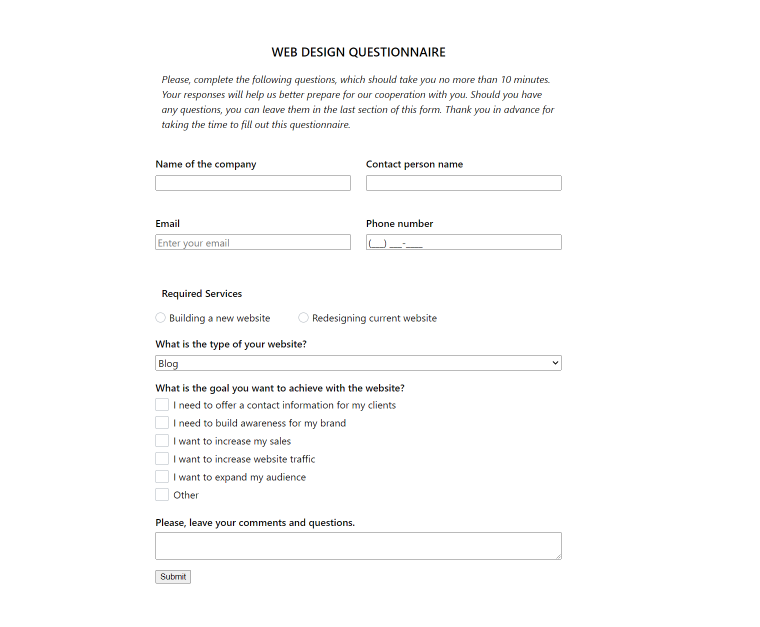
If you explain so clearly that nobody can misunderstand, somebody will. I dare to propose a corollary to this Murphy’s law: Asking clarifying questions is crucial. In web design, as in any creative project, misunderstanding between a customer and a designer can lead to longer project duration and a website with many “crutches” and “patches.”
Through trial and error, many designers understand why a website design questionnaire is a must-have. But googling “questionnaire template” gives way too wordy explanations.

Feel free to download the ready-made form and import to your WordPress dashboard.
One of the great functionalities I used for building the questionnaire is conditional logic. With its help, I could hide certain questions and entire groups of questions if they were irrelevant to the client, which I could figure out based on previous answers.

In my case, I programmed the block of questions about the current client’s site to be visible if the client selects Redesigning current website to answer the Required services question. It’s straightforward and only takes a few clicks. These questions are unnecessary for a customer who doesn’t require such services and only make the questionnaire look massive for no reason.
I also used this feature to suggest the clients can come up with their own answer if they didn’t find the right option from the drop-down menu. The difference from a simple empty text field is that I suggested what kind of answers I expect to receive.
By the way, I used another free Crocoblock WordPress tool JetStyleManager to style up the layout a bit and create a uniform typography for the form.
Finally, you can choose and combine an array of post-submit actions, including sending an email, registering a user, and redirecting to a checkout page. For my questionnaire, I selected Save Form Record. After attaching a form to a web page, the results from all submitted forms are visible in JetFormBuilder > Form Records sections.

Unfortunately, good ideas often stumble over implementation, even if you discuss as much as possible at the initial stage.
I find the following tips and tricks to be helpful for website design questionnaire development:
There are no requirements, but the main thing is the client’s convenience and the completeness of the information received.
What is the correct structure of the questionnaire?There is no strict structure, but a comprehensive web design client questionnaire must include questions about important factors, such as brand personality, target audience, and client’s budget.
Can I use online services for a questionnaire posted on social nets?Yes, you can use any service, in particular, mentioned above.
What happens after completing the questionnaire?Designers will create a client’s price list with all the necessary work to develop your site.
What to do if the client does not know how to answer?The clients are not always ready to fill out the questionnaires independently. In this case, you can meet with them or call them to fill out the questionnaire together. If there are difficulties, ask the clients for the contact details of the trustees to discuss all issues with them.
The best ideas start with well-defined goals. The specific needs and restrictions do not limit your fantasy but give the general vision of the future design. Ask the right questions, but do not make the questionnaire too long and tedious.
When creating a web design questionnaire, you should ponder the questions and their presentation. Thus, your questionnaire could turn out exciting and picturesque. It should be another hook to attract clients’ attention and start a long-term cooperation.